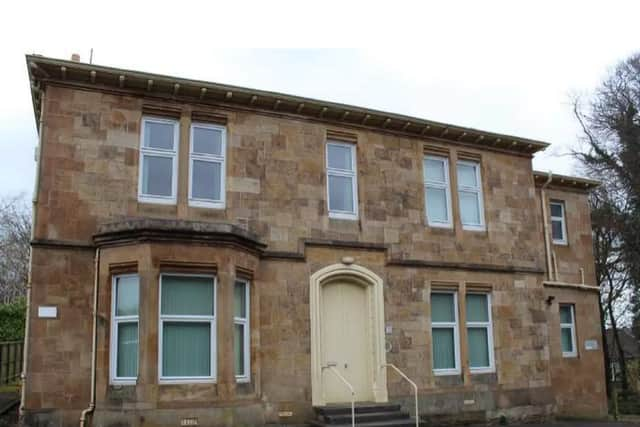Remaking Glasgow: Former Langside convent to be knocked down despite planners’ recommendation
and live on Freeview channel 276
Glasgow’s planning committee has approved a proposal to build 16 homes for private sale across a five-storey block on a site at 32 Mansionhouse Road, currently occupied by a sandstone villa which was formerly part of the Bon Secours Hospital.
Officials believed the plan should be rejected as it would “unacceptably harm the amenity of existing properties at 36A Mansionhouse Road due to loss of daylight to habitable rooms”.
Advertisement
Hide AdAdvertisement
Hide AdThere were also almost 80 objections from members of the public, with opponents calling for the building to be saved. Planners initially said the project could go ahead, but changed their recommendation when new information on how the planned flats could cause a loss of daylight to nearby homes was received.


Representatives for the applicant, Surplus Property Investments Ltd, argued the “single issue” of daylighting should “not be significant enough on its own to change the position from one of support to refusal”.
After a hearing yesterday, one of the objectors, Peter Kelly, of Camphill Avenue, said residents had been “shocked and disappointed” by the decision.
“Not only does it fly in the face of the recommendation to reject the planning application from their own officials, but is contrary to the view of the local community council and 78 residents that lodged complaints.
Advertisement
Hide AdAdvertisement
Hide Ad“It also goes against the stated intentions of council policy to retain historic sandstone buildings in Glasgow whenever possible. Instead of listening to local people and their own officials, councillors have opted to side with developers in construction of more luxury flats.”
The planning committee voted seven to two in favour of granting planning permission, with only the chairman, Cllr Ken Andrew, SNP, and Cllr Kenny McLean, SNP, supporting the view of officials.
Cllr Thomas Kerr, Conservative, said: “We have seen what has happened in Bridge Street [India Buildings roof collapse] to buildings that end up in a state of disrepair. I’m worried the longer we leave this building, the longer that’s going to be the situation it could be in.”
He added the city is facing a “housing crisis” and the daylighting issue is a “minor detail”. “I don’t think that’s a reason to refuse,” he said. “I believe no matter how we try to develop on this site, because of the nature of the site it is going to be tricky.”
Advertisement
Hide AdAdvertisement
Hide AdCllr Andrew said he acknowledged the housing crisis, but: “Producing buildings that are then impacting on other residents is not the way forward. That’s how we end up with over-concentration of housing. There’s clearly a failure in the daylighting tests.”
He was disappointed the developers were “not content to look at reducing the height of their proposal” and he hoped “something more imaginative” could have been done with the building.
Officials reported the building isn’t listed or within a conservation area and the developers have shown restoration isn’t “financially viable”.
The report added the proposals would have “a negative effect on at least four habitable rooms” at 36A Mansionhouse Road. “In all cases, this is the sole source of natural light to these rooms,” it stated.
Advertisement
Hide AdAdvertisement
Hide AdAn official told the hearing that the planning department has “started to take a more considered approach to the assessment of daylighting”. “Previously we had not picked up the failure to these properties,” he said.
Ewan Proctor-Mason, the lead architect on the project, said: “In all other issues other than daylight we are now in accordance with Glasgow City Council planning policy.”
He added: “We would suggest the single issue of daylighting should not be significant enough on its own to change the position from one of support to refusal.”
Gary Mappin, director at Iceni Projects, the applicant’s agent, said: “In my experience it would be unusual for a development of this nature, in such a location, to fully satisfy daylight and sunlight criteria.”
Advertisement
Hide AdAdvertisement
Hide AdHe added the council had approved many similar schemes recently.
Approved many similar schemes. “In a city that’s declared a housing emergency, what we have here are open market flats proposed by a locally based SME [small and medium-sized enterprise].
“It’s a high quality energy-efficient and sustainable design, I believe it’s a very good scheme.”
In response to questions from the committee, he said there is “not necessarily” anything wrong with the structure of the property, but it is the “cost to bring that building back into use”. “That would be things like roof repairs, wiring and electricity, plumbing.
Advertisement
Hide AdAdvertisement
Hide Ad“All of those have been costed and that’s not taking into account the significant inflation in building materials. Basically, it would cost more than the building would be worth.”
Mr Kelly said conversions elsewhere on Mansionhouse Road showed what was possible. It may be a “smaller profit”, he added, but that “smaller profit should be the price of retaining the historic character of the neighbourhood”.
He said councillors justifying their decision as helping to address the housing emergency is “laughable”. “We want to see buildings like that on Mansionhouse Road brought back into residential use, but demolishing them is not the way to do that.”
Comment Guidelines
National World encourages reader discussion on our stories. User feedback, insights and back-and-forth exchanges add a rich layer of context to reporting. Please review our Community Guidelines before commenting.